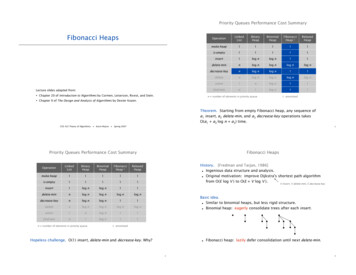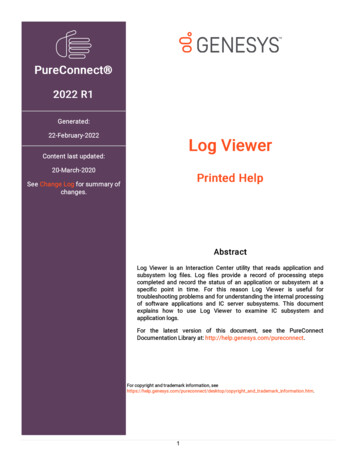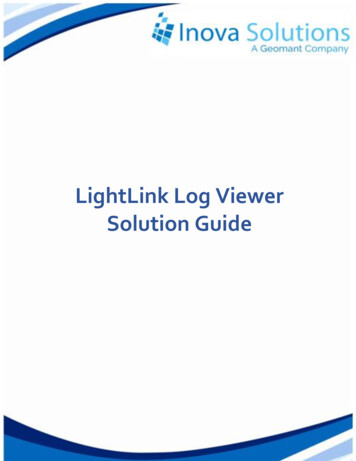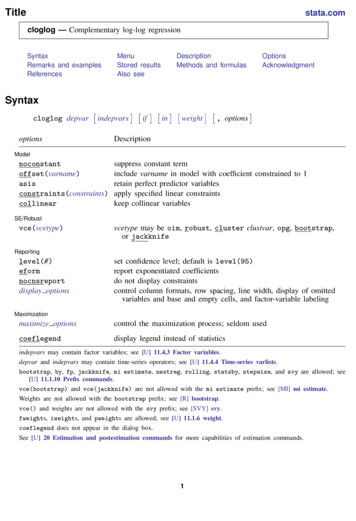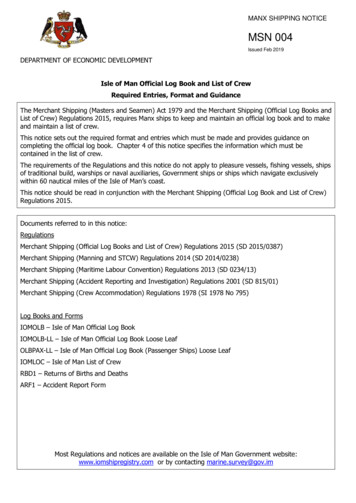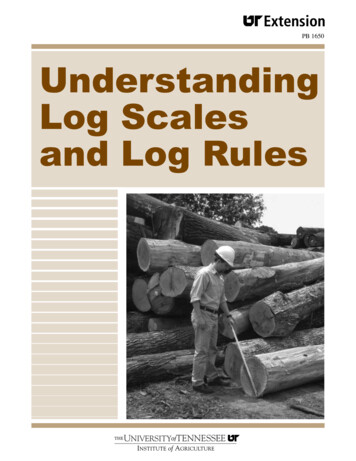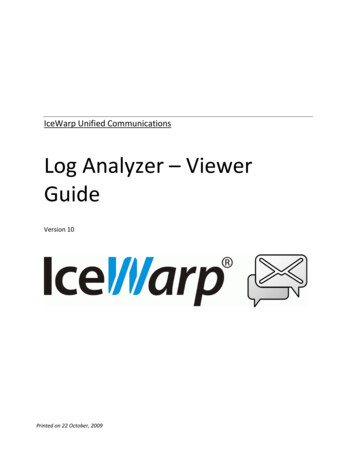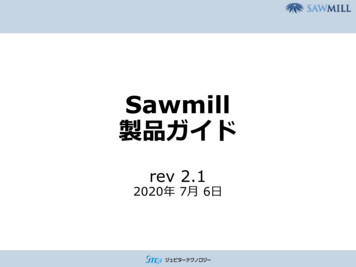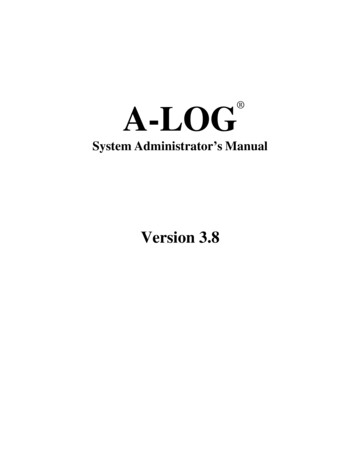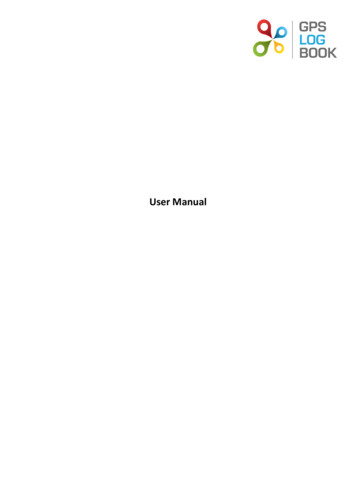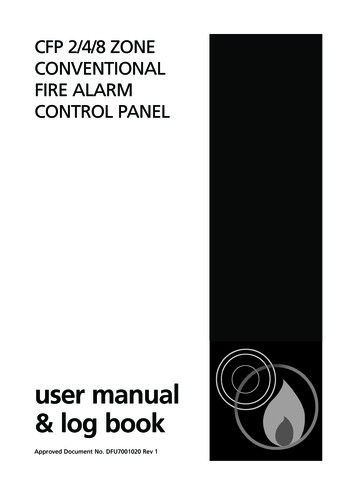
Transcription
CFP 2/4/8 ZONECONVENTIONALFIRE ALARMCONTROL PANELuser manual& log bookApproved Document No. DFU7001020 Rev 1
CFP 2/4/8 ZONE CONVENTIONAL FIRE ALARM PANELCONTENTSSafety .3Important information regarding the safe use of this fire alarm panelCFP Key Features .3Lists the different features available on the CFP range of conventional fire alarm panelsFire Alarm Systems - An Overview .4How fire alarm systems operate and a general overview of their key featuresUser Responsibilities .5General guidelines on what the user is expected to doPanel Layout/Accessing the Controls .6A summary of the controls and indicators available on this fire alarm panel, including:Control level definitionHow to access the panel’s secure user functionsWhat the indicator lights meanFire Conditions .8HowHowHowHowan alarm is indicated, and how to deal with itto silence the alarm soundersto manually activate the alarm sounders (i.e. to evacuate the building)to reset a fire alarm conditionFault Conditions .9The different types of fault that may occur, what they mean and how to deal with themDisablements .10How to inhibit the functionality of certain parts of the fire alarm systemNotes on Delays .12Important information about delays, what they mean and what you should do about themSystem Set-Up Data Chart .13Details of how the system has been set-upFire Alarm Log Book .14A place for you to record details of events such as fires, false alarms, call outs, etc.Certificate of Installation.19Certificate of Commissioning.20 Errors & Omissions Excepted. The manufacturer of this product operates a policy of continuous improvement and reserves theright to alter product specifications at its discretion and without prior notice. All of the instructions covered in this manual havebeen carefully checked prior to publication. However, no responsibility can be accepted by the manufacturer for any inaccuraciesor for any misinterpretation of an instruction or guidance note.CFP USER MANUAL Approved Document No. DFU7001020 Rev 1 Page 2 of 20
CFP 2/4/8 ZONE CONVENTIONAL FIRE ALARM PANELSAFETYThe fire alarm panel is safe to operate provided it has been installed in compliance with the manufacturer’sinstructions and used in accordance with this user manual.Do not operate the fire alarm panel with its enclosure open. There is no need to open the enclosureexcept to carry out commissioning, maintenance and remedial work. This work must only be carriedout by competent service personnel who are fully conversant with the contents of the separateengineering manual for this product and have the necessary skills for maintaining this equipment.If the enclosure is damaged in any way, expert advice should be sought regarding its repair.Regular servicing of the fire alarm system is highly recommended, preferably on a continuous maintenancecontract and by a competent organisation. A full-itemised report of the installation should be obtained atleast annually.CFP KEY FEATURESPANELFEENAT54URPartsES2&4ComLPCBp lianAptproveZodnedel ayNonfalatcilitychin gzone(dsfou Cacble oinilit-kn cidye*oc nck) efaZocilneitytes*tfacProilitygon ramne souwFaala nderultrm sdiagnosAnticfacfo cillarsilityst ry coiesem nnee x c tipa on(AnsUX On-bion sFir oare& drFa elayCultke ombsysw inOutpuitc ed khvt)ers eypai on d aava ndilableThe key features chart (below) illustrates different features available on the CFP range of fire panels.Hint: The panel label will help you identify the CFP type.This user manual details all the available features therefore, some sections of this manual may not beapplicable to the model you are using.CFP PANEL RANGECFP LPCB Approved PanelCFP PanelCFP Economy Panel* Non-EN54 Part 2 panel features:CoincidenceNon-latching zones facilityThis product has been manufactured in conformance with the requirements of all applicableEU Council Directives.CFP USER MANUAL Approved Document No. DFU7001020 Rev 1 Page 3 of 20
CFP 2/4/8 ZONE CONVENTIONAL FIRE ALARM PANELFIRE ALARM SYSTEMS – AN OVERVIEWThe primary purpose of a fire alarm system is to provide an early warning of a fire so that people andanimals can be evacuated and action taken to stop the fire as soon as possible - all according to apredetermined plan.Alarms may be raised automatically by smoke or heat detectors, or manually by a person operating a manualcall point.To ensure an alarm is dealt with in an orderly manner, it is important to know where the alarm is comingfrom. To aid this function, fire alarm systems are usually split into zones, each covering a different area of abuilding.When an alarm has been raised, the fire alarm panel responds by indicating the zone in which the alarm hasoccurred and activating all relevant sounders, bells and other alarm outputs to provide a warning of the fire.Additional alarm outputs available on the CFP range of fire alarm panels (which may, or may not be useddepending on the requirements of the site) are: A Remote Output: this output is activated when the panel is in alarm and is returned to normal whenthe alarm sounders are silenced. It may be used to signal an alarm condition to other parts of the firealarm system. If used, its function will be declared on the System Set-Up Data Chart (page 13) of thismanual. This output may be disabled if required. An Auxiliary Output: this output is activated when the panel is in alarm and is returned to normalwhen the panel is reset. It may be used to signal an alarm condition to other parts of the fire alarmsystem. If used, its function will be declared on the System Set-Up Data Chart (page 13) of this usermanual. This output may be disabled if required.The building’s fire management plan should always be executed when the fire alarm panel goes into alarm.See User Responsibilities (page 5) for further details.Fault monitoringFor obvious reasons, the reliability of the fire alarm system is paramount. To this end, the fire alarm panelcontinuously monitors all connections between detectors, manual call points and sounders and also checksits own power supply and back-up batteries for faults.If a fault is detected anywhere on the system, the panel responds by illuminating one or more of the Faultlight(s) located on the panel front and sounding its internal fault buzzer. The panel’s fault output is alsoactivated, sending notification of the fault (if connected) to a remote manned monitoring centre or otherelectronic equipment, as required.DelaysCertain zones on a fire alarm system can be prone to conditions that lead to frequent and unavoidable falsealarms, a common example being a loading bay filled with vehicle smoke. In such areas it may be acceptableto delay the activation of the alarm sounders and other outputs to give a responsible person time toinvestigate the cause of the alarm. If the cause is found to be a true fire hazard, the delay can be overridden.In the event of a false alarm, the panel can be reset. Should the delay period expire without any userintervention, the alarm sounders will automatically sound to evacuate the premises. To ascertain if anydelays have been programmed into the panel, refer to the System Set-Up Data Chart (page 13).DisablementsIn abnormal conditions, certain parts of the fire alarm system can be temporarily turned off (disabled) to suitprevailing conditions. For example, if there is a risk of a false alarm occurring in a zone, say from vehicleexhaust smoke in a loading bay, it is possible to disable that zone during the risk period, then enable it againafterwards. Another example is the disablement of outputs during a routine test or temporary fault.CoincidenceThe consequence of a false alarm on some fire alarm systems, particularly those connected to sprinkler orgas extinguishant systems, can be onerous. To help reduce the risk of a false alarm, certain zones on thesystem can be coupled together so that the alarm sounders and outputs only activate when there is a firecondition on both zones. The only way to tell if and how this feature has been utilised is to refer to theSystem Set-up Data Chart (page 13).CFP USER MANUAL Approved Document No. DFU7001020 Rev 1 Page 4 of 20
CFP 2/4/8 ZONE CONVENTIONAL FIRE ALARM PANELUSER RESPONSIBILITIESBS5839-1 is the British Standard code of practice for the design, installation, commissioning andmaintenance of fire detection and fire alarm systems for buildings. Section 7 of the standard (UserResponsibilities) states that a named responsible person should be appointed to supervise all matterspertaining to the fire alarm system {clause 47.2a}.Highlighted below is a summary of the main functions of the responsible person is expected to carry outwith regard to BS5839-1 only. It does not highlight any other responsibilities that may be required of theuser or responsible person that is listed in documentation such as the Employers Guide to Fire Safety, theFire Precautions (Workplace) regulations and/or any other legislation relevant to the premises. If in doubt,the fire authority can advise on the fire legislation that applies to any given building.For countries outside the UK, different user responsibilities may apply.BS5839-1 states the responsible person should:(The bracketed numbers {xx} identify the BS5839-1 clauses to which the summary refers).123456789Ensure the fire alarm panel is checked daily to confirm there are no faults on the system {47.2b}.Ensure arrangements are in place for the test, maintenance and regular servicing of the system withregard to Section 6 of the standard {47.2c}.Important: Clause 44 of BS5839-1 recommends weekly and monthly tests that should be carried out bythe user/responsible person - please refer to the bottom of this section for further details.Ensure the system log book is kept up to date by recording fire signals, fault signals, work on thesystem, etc, and make sure it is available for inspection at all times {47.2d/48}.Ensure that all relevant occupants of the protected premises are instructed in the proper use of thesystem {47.2e}.Take steps to limit the number of false alarms on the system {47f}.Ensure the effectiveness of the system is not impaired by ensuring there is a space of at least 500mmin all directions around and below every fire detector and that all manual call points areunobstructed and easy to see {47g}.Liaise with all relevant building engineers, decorators, etc., to ensure any changes to (or maintenanceof), the building’s fabric does not compromise the protection given by the fire alarm system, createfaults or false alarms {47h}.Ensure that any structural or occupancy changes planned for the building are done so with due andearly consideration given to any changes that may be required to the fire system {47h}.Ensure that a selection of spare parts are held as appropriate within the premises {47j}.Routine weekly and monthly testing to be undertaken by the user/responsible person:To meet the requirements of Clause 44 of BS5839-1 we recommend the following tests are carried out atapproximately the same time each week, during normal working hours:Note: It is essential any alarm receiving centre is contacted before and after these tests to avoid unwantedalarms and to confirm the fire signal is correctly received. Carry out an indicator lamp test to check all Zone lights show and the beeper sounds.Operate a manual call point or smoke/heat detector to test the fire alarm.Check that the alarm sounders operate.Reset the system by pressing the Silence/Resound Sounders button and Control Panel Reset button.Verify that no manual call points or smoke/heat detectors are obstructed in any way.Test a different zone each week using a different call point or detector so all are tested in rotation.Monthly attention: Ensure authorised service personnel verify the system’s standby power supply (orsupplies) are in good working order.Quarterly and periodic inspection, testing, servicing and maintenanceIt is the user’s responsibility to ensure that an ongoing periodic plan is in place that meets Clause 45(Inspection and Servicing) of BS5839-1. The work required to meet this Clause must be carried out by acompetent person with specialist knowledge of fire detection and alarm systems.The standard recognises this will normally be an outside specialist fire alarm servicing organisation.Please note: the above summaries do not replace Sections 6 and 7 of BS5839-1 but are intended to help the user gain agreater understanding of his or her responsibilities. We strongly recommend the named responsible person familiarisesthemselves with the full and current standard, copies of which are available from your local reference library or can bepurchased from the British Standards Institute, Customer Services Dept., 389 Chiswick High Road, London, W4 4AL. Tel: 44 (0)20 8996 9001. Web: www.bsi-global.com.CFP USER MANUAL Approved Document No. DFU7001020 Rev 1 Page 5 of 20
CFP 2/4/8 ZONE CONVENTIONAL FIRE ALARM PANELPANEL LAYOUT/ACCESSING THE CONTROLSThe fire alarm panel allows both keyswitch and keypad entry methods for entering access level two.Note: Repeater Fault and Output Delays lights are not on the CFP Economy Panel.132Fire54768Fire status1silence internalsounder2exit accessmodesilence/resoundsoundersnext optionsupply remotecontrol panel present output34enable/disablelamp testZone setIOgeneral power system repeaterfault supply faultfaultfaultsounder auxiliary outputstatus output delaysstatusTwo levels of control are available to user(s) of this fire alarm panel; General User and Authorised User.1. General User Controls (access level one)When the panel is in access level one, the indicator lights on the panel front give a comprehensiveoverview of the system’s current status. Any fire and fault conditions are clearly displayed, disablementshighlighted and the status of all outputs reported. For detailed descriptions of what each light means,see page 7.The only functions that can be performed by the user when the panel is in access level one are: Muting the panel’s internal sounder by pressing the Silence Internal Sounder button;Overriding any delays (CFP model dependent - see page 3) which may have been programmedinto the panel by pressing the Silence/Resound Sounders button (only applicable when the panelis in alarm); orPutting the panel into access level two (the Authorised User state) - see below.2. Authorised User Controls (access level two)To avoid unauthorised changes to critical parts of the fire alarm system, controls such as silencing thesounders, resetting an alarm condition and setting disablements are only accessible via a secure methodof entry which puts the panel into access level two.To put the panel into access level two using keypad entry:Enter the code 2 1 4 3 using the keypad buttons on the panel front. During the code entry sequence, thepanel’s Accessed light will pulse. If an incorrect sequence of numbers is entered after four button pressesthe Accessed light will stop pulsing and you must enter the code again. When the correct code is entered,the Accessed light will be lit steady to indicate that the controls are operative. To exit access level two,press the Exit Access Mode button.To put the panel into access level two using the keyswitch:Turn the key to the ‘I’ position (Note: The key cannot be removed when in this position). When the keyis in the ‘I’ position, the Accessed light will be lit steady to indicate that the controls are operative.To exit access level two, turn the key back to the ‘O’ position.Details of how to use the Authorised User controls can be found on pages 8 to 11 of this user manual.CFP USER MANUAL Approved Document No. DFU7001020 Rev 1 Page 6 of 20
CFP 2/4/8 ZONE CONVENTIONAL FIRE ALARM PANELWhat the indicator lights meanThe table below summarises the various indicators available on the fire alarm panel and what they mean in theirvarious states. The final column highlights the pages(s) you should turn to for further information.LIGHTSTATUS OF LIGHTFlashing RedFIRE(General Fire)Fire Zones1 to 8Zone Fault/Disable/Test1 to 8WHAT THIS MEANSFURTHER READINGThe panel has detected a fire alarm condition, or Page 8 (Fire Conditions)the Silence/Resound Sounders button has beenpressed to evacuate the buildingSteady RedThere is a silenced fire alarm condition on thesystemFlashing RedA fire alarm condition has been detected on thezones which are flashingSteady RedThere is a silenced fire alarm condition on thezones which are lit steadyFlashing YellowFaulty wiring has been detected on the zones Page 9 (Fault Conditions)(in sync. with the which are flashingGeneral Fault light)Flashing Yellow(in sync. with theTest light)The zones which are flashing are in test modeSteady YellowThe zones which are lit steady have been disabled Page 10 (Disablements)Supply PresentSteady GreenThe panel is supplied with powerRemote OutputSteady RedTestFlashing YellowThe panel is in test modeAccessedFlashing YellowThe access code is in the process of being enteredGeneral DisablementFlashing YellowSteady YellowFault Output StatusRemote Output StatusThe panel is in access level twoThe panel is in the disablement selection stateSteady YellowThe fault output has been disabledThe remote output has been disabledPage 10 (Disablements)Page 9 (Fault Conditions)Flashing YellowA fault has been detected on the systemPower Supply FaultFlashing YellowThe panel has detected a fault with its powersupply, battery charger or back-up batteriesSystem FaultFlashing YellowThe panel has detected a microprocessor faultFlashing YellowThe panel has detected a wiring/communicationfault on the repeater networkFlashing YellowFaulty wiring has been detected on the panel’ssounder circuitsOutput Delays (CFPmodel dependent - seepage 3)Page 10 (Disablements)A fault has been detected on the output’s auxiliary Page 9 (Fault Conditions)24V supplyGeneral FaultAuxiliary Output StatusPage 10 (Disablements)Part of the system has been manually disabled Page 10 (Disablements)and/or one or more of the fire zones have a delay Page 12 (Notes on Delays)applied to them (CFP model dependent - see page 3)Steady YellowSounder StatusPage 6 (Accessing the Controls)Steady YellowFlashing YellowRepeater Fault (modeldependent - see page 3)Page 4 (Overview)The remote output has been activatedSteady YellowThe alarm sounders have been disabledPage 10 (Disablements)Steady YellowThe panel’s auxiliary output has been disabledPage 10 (Disablements)Steady YellowDelays have been programmed into the panelPage 12 (Notes on Delays)Flashing YellowA delay is runningTesting the indicator lightsTo test the panel’s indicator lights are working correctly, press the Lamp Test button when the panel is in theaccessed state. The panel’s internal beeper also sounds when pressing this button to show it is working correctly.CFP USER MANUAL Approved Document No. DFU7001020 Rev 1 Page 7 of 20
CFP 2/4/8 ZONE CONVENTIONAL FIRE ALARM PANELFIRE CONDITIONSFire Zone LightsGeneral Fire LightFire ZonesFire12345678When the fire alarm panel receives an alarm trigger from a detector or manual call point located in a zone thatis not already in a fire state, it will: Flash the general fire and appropriate Fire Zone light(s) on the panel front.Activate its internal sounder.Start the alarm sounders and outputs including, if enabled, the remote and auxiliary outputs(provided there are no delays applicable to the zone which is in alarm - CFP model dependent, see page 3).At this point the building’s fire management plan should be executed!Important Note: Zones which have been disabled cannot be triggered into an alarm condition(see page 10 for further information on disablements).Silencing the alarm sounders The alarm sounders may be silenced by putting the panel into access level two and pressing theSilence/Resound Sounders button.The alarm sounders and the panel’s internal sounder will stop sounding and the light(s) for the zone(s) inalarm and the General Fire light will be lit steady. The remote output will turn off, but the auxiliary outputwill stay on.New zone in alarmShould a new zone be triggered into alarm whilst the alarm sounders are silenced, the panel will: Automatically reactivate the alarm sounders (if programmed to do so). Flash the General Fire light and appropriate Fire Zone light(s) for any new zone(s) in alarm.Keep the light(s) for the previous zone(s) in fire lit steady.Manually activating the alarm sounders (i.e. to evacuate the building) Momentarily pressing the Silence/Resound Sounders button when the panel is in access level two(see page 6) will cause the alarm sounders to sound. Note: The panel’s remote and auxiliary fire outputswill not be triggered when the building is manually evacuated in this way.Pressing the Silence/Resound Sounders button again will silence the alarm sounders.Note: If the sounders have been disabled, pressing the Silence/Resound Sounders button will have noeffect.Resetting the panel After the cause of the alarm has been investigated and cleared and the alarm sounders have beensilenced, the panel can be reset by pressing the Control Panel Reset button.The panel will give a double beep to indicate the reset process has started and, after a few seconds, theFire Zone and General Fire lights will go out to indicate the process is complete. If there are still alarmtriggers on any zone the panel will go back into alarm as before.CFP USER MANUAL Approved Document No. DFU7001020 Rev 1 Page 8 of 20
CFP 2/4/8 ZONE CONVENTIONAL FIRE ALARM PANELFAULT CONDITIONSWhen a fault occurs on a critical part of the fire alarm system, the panel responds by activating its internalsounder and illuminating the General Fault light and any other Fault light(s) relating to the fault. The panel’sfault output will also activate (provided it hasn’t been disabled). The type of faults typically indicated at the firealarm panel are described below:General FaultZone FaultsFlashes when there is a fault on any partof the fire alarm system. It is always lit insync. with at least one other Fault lightwhich displays precise information on thetype of fault detected.The relevant Zone Fault light flashes when there is a wiringproblem on a zone or a detector has been removed from its base.Note: Any alarms raised on the faulty zone(s) may not berecognised by the fire alarm panel until the fault condition hasbeen cleared.12345678Zone fault/disable/testsupply remotepresent em tussounder auxiliarystatus outputstatusPower Supply FaultSystem FaultFlashes when the Mains supplyhas failed, or the standbybatteries or its charger arefaulty.If the Mains supply fails, thepanel will only operate for thestandby period determined bythe size of the batteries fitted.If the batteries or charger failat the same time as the Mains,the panel will not operate.Flashes when the panel’smicroprocessor has reset,typically after excessiveelectrical interference, or ifthe contents of its memoryhave been corrupted. Thisfault can only be cleared bypressing the Control PanelReset button. If the faultre-occurs within twominutes, this indicatescorrupt memory and expertadvice should be sought.remoteoutputstatusRemote Output FaultThis light flashes whenthere is a fault on therelevant output’sauxiliary 24V supply.outputdelaysRepeater Fault(CFP model dependent- see page 3)Flashes when theconnection betweena repeater fire alarmpanel (if fitted) andthe master fire alarmpanel fails.Depending on wherethe fault hasoccurred, some or allof the repeaters maynot operate.Sounder StatusFlashes when there is awiring fault on thesounder circuits.Depending on wherethe fault has occurred,one or all of the alarmsounders may notoperate.In the event of a fault condition: Mute the panel’s internal sounder by pressing the Silence Internal Sounder button (the panel does nothave to be in access level two to do this).Record the fault(s) in the Fire Alarm Log Book (page 14) and take appropriate action to correct it/them.See User Responsibilities (page 5).When a fault has been rectified the indicator light for that fault is automatically turned off. If all faults arecleared, the General Fault light will go out, and the panel’s internal sounder will be silent (if not alreadymuted). If the fire alarm panel is reset any existing fault(s) will reappear as before and the silencing process willhave to be repeated.CFP USER MANUAL Approved Document No. DFU7001020 Rev 1 Page 9 of 20
CFP 2/4/8 ZONE CONVENTIONAL FIRE ALARM PANELDISABLEMENTSCertain fire alarm panel functions can be temporarily disabled (i.e. switched off) to suit certain conditions. Forexample, if there is a risk of a false alarm in a zone, e.g. from vehicle exhaust smoke in a loading bay, it is possiblefor the user to disable that zone during the risk period and enable it again afterwards. Another example is thedisablement of outputs during a routine test or temporary fault.The following is a list of options that may be disabled by a level two user at the fire alarm panel and the effecttheir disablement will have on how the system works:OPTIONEFFECT ON SYSTEM WHEN DISABLEDZone 1Alarms and faults on zone 1 will not be processedZone 2Alarms and faults on zone 2 will not be processedZone 3 (only available if fitted)Alarms and faults on zone 3 will not be processedZone 4 (only available if fitted)Alarms and faults on zone 4 will not be processedZone 5 (only available if fitted)Alarms and faults on zone 5 will not be processedZone 6 (only available if fitted)Alarms and faults on zone 6 will not be processedZone 7 (only available if fitted)Alarms and faults on zone 7 will not be processedZone 8 (only available if fitted)Alarms and faults on zone 8 will not be processedFault OutputFaults will not be transmitted to any other equipment (if fitted)Remote OutputAlarms will not be transmitted to remote equipment (if fitted)SoundersThe alarm sounders will not operate in a fire conditionAuxiliary OutputAlarms will not be transmitted to local fire fighting equipment (if fitted)Output Delays (only available if See ‘Notes on Delays’ (page 12) for information regarding delays beforedelays have been programmed attempting to alter this function. CFP model dependent - see page 3.into the panel by an engineer)To disable or enable any of the above options:1.Put the fire alarm panel into access level two (see Authorised User Controls - page 6).2.Start the selection process by pressing and holding the Next Option button for 3 seconds.The General Disablement light will flash and the Fault light relating to the first option in the above table willflash to show it is selected.If the light flashes at a slower rate than the General Disablement light, the option is enabled.If the light flashes at the same rate as the General Disablement light, the option is disabled.3.If necessary, press the Enable/Disable button to toggle the selected option between disabled and enabled.4.To confirm your choice, press the Next Option button.This will move the selection process on to the next available option in the above table and the Fault lightrelating to this new option will flash to show it is selected. The previous option’s Fault light will now be litsteady to confirm it is disabled, or switched off to confirm it is enabled.5.Repeat steps 3 & 4 for every available option until the selection process is complete.The disablement/enablement process is complete when all available options have been selected in turn and theNext Option button is pressed for the last time. At this point all disabled options will be lit steady and allenabled options will have their lights switched off.Note: The selection process can be exited at any time by pressing the Exit Access Mode button, or by turningthe keyswitch to ‘O’ position. The only changes that will be saved will be those made prior to the last press ofthe Next Option button.CFP USER MANUAL Approved Document No. DFU7001020 Rev 1 Page 10 of 20
CFP 2/4/8 ZONE CONVENTIONAL FIRE ALARM PANELTo avoid confusion, during the selection process any light in the table of options that was showing afault condition will have the fault indication turned off. After the selection process is complete, faultindication will be restored unless that option was disabled during the selection process.Notes about dis
The fire alarm panel is safe to operate provided it has been installed in compliance with the manufacturer's instructions and used in accordance with this user manual. Do not operate the fire alarm panel with its enclosure open. There is no need to open the enclosure except to carry out commissioning, maintenance and remedial work.
